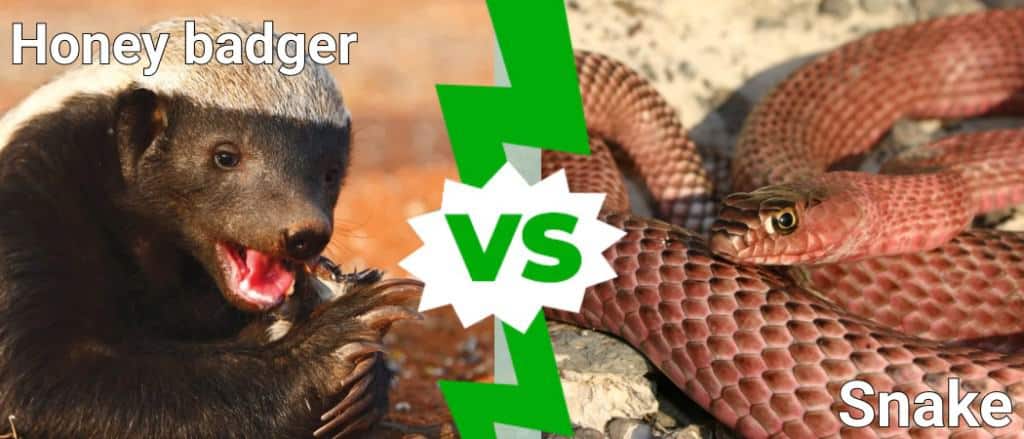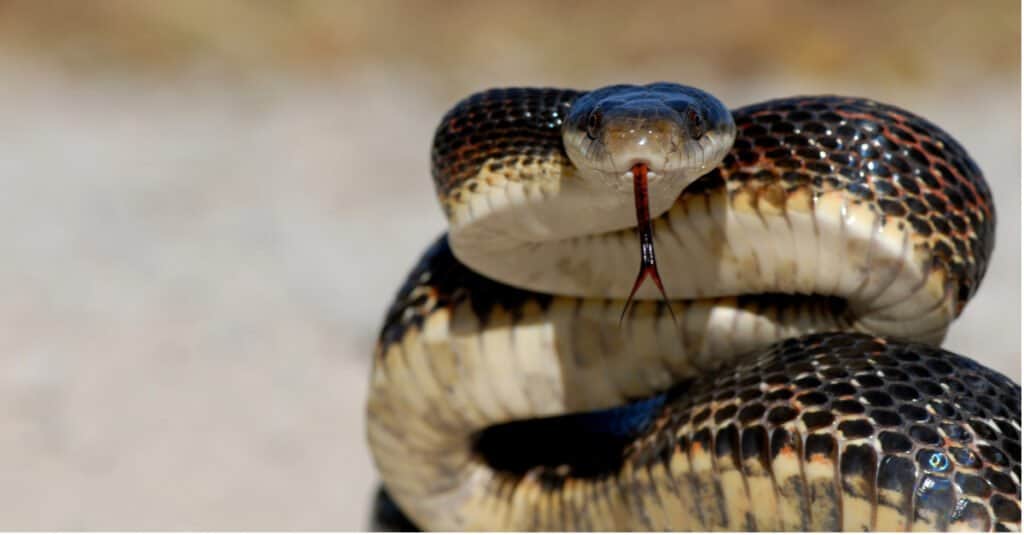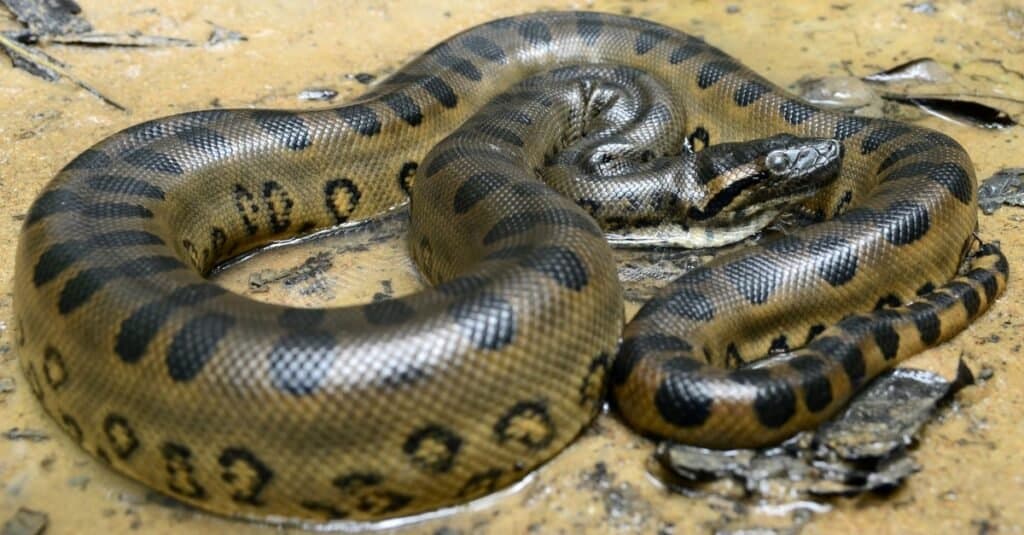Honey badgers are frequently regarded as some of the toughest creatures to walk the earth. They seek out fights with powerful creatures, and they often emerge as the victor or at least fight them to a standstill. However, some animals are deadlier than others, and snakes are certainly counted among the deadliest in existence. After all, snakes kill between 81,000 and 150,000 people per year. What happens when a honey badger faces off against a snake? We’ll show you how a honey badger vs snake plays out and which animal lives to see another day.
Comparing a Honey Badger and a Snake

| Honey Badger | Snake | |
| Size | Weight: 11lbs to 40lbs Length: 1.5ft – 2.5ft | Weight: 5lbs – 20lbs average (much greater exists) Length: 36in on average (much greater exists) |
| Speed and Movement Type | – 19 mph top speed | – 1-3 mph on average, faster species, like the sidewinder, move up to 18 mph. – Undulating body motions on the ground is the primary form of locomotion. |
| Senses | – Great sense of smell – Good sense of hearing – Poor eyesight like most other Mustelids | – Some snakes can sense heat with specialized “pits.” – Flicking their tongues aids with their sense of “smell.” – Most snakes have poor vision – Can only hear low frequencies |
| Defenses | – Exceptionally thick skin that resists bites, stabs, stings, and blows – Overpowering musk that can make predators flee | – Threat displays – Ability to hide in trees and water – Camouflage helps them blend in with their surroundings |
| Offensive Capabilities | – Sharp claws – Powerful, well-aimed bites – Can turn the tables on enemies in close quarters | – Fangs, some with small grooves that may inject venom. – Can wrap themselves around their prey and crush them to death |
| Predatory Behavior | – Pursuit predators – Their teeth are sharp enough and their jaws powerful enough to bite through tortoise shells. – Digs prey out of burrows | – Ambush predators |
What Are Key Differences Between a Honey Badger and a Snake?

Snakes are deadly reptiles, while honey badgers are fierce mammals
©Rusty Dodson/Shutterstock.com
The biggest differences between a honey badger and a snake are their size, morphology, and methods of hunting. Honey badgers are larger than the average snake, are quadrupedal mammals compared to limbless reptiles, and use pursuit predation, whereas snakes ambush their foes.
These differences are vast in terms of their bodies, movement styles, and more. Although their differences are numerous, honey badgers and snakes are most alike in the sense that they can have very aggressive demeanors. Popular memes insist that the honey badger doesn’t care, and its willingness to fight off bigger creatures, including lions, proves that fact.
Still, understanding how these animals are unique helps inform us about what elements of their physiology and mentality provide them with the greatest leverage to win a bout.
What Are the Key Factors in a Fight Between a Honey Badger and a Snake?

Size and speed both play major roles in helping a snake secure a kill.
©Patrick K. Campbell/Shutterstock.com
A honey badger vs snake fight requires an in-depth examination of all circumstances that would play a part in the battle. We’ve narrowed down these factors to five elements that include physical traits and each animal’s fighting abilities. By examining each animal in light of these traits, we’ll be able to see which one has the most advantages and has the best chance of survival.
Honey Badger vs Snake: Size
Honey badgers are larger than most snakes. On average, a honey badger will weigh up to 40lbs and grow 2.5ft long. Snakes run the gamut of sizes, but their average is about 5-30lbs in weight and 3 feet long. However, several species of longer, heavier snakes exist, including reticulated pythons and anacondas.
Honey badgers have a size advantage over most snakes that inhabit their part of the world, so they get the advantage.
Honey Badger vs Snake: Speed and Movement
On average, honey badgers can run at 19 mph, but snakes can only move between 1 and 3 mph. Honey badgers trot and gallop while snakes use an undulating motion to move on the ground. Some snakes can reach much higher speeds, including the sidewinder.
Honey badgers have a significant advantage in terms of speed and movement.
Honey Badger vs Snake: Senses
The honey badger has a poor sense of sight, but it can smell and hear very well, and that allows it to find its prey. Snakes have specialized sensory organs that can help them detect chemicals in the air as well as heat. Those are all the senses they need to find prey, though.
Overall, snakes have more specialized senses, so they have an advantage in senses.
Honey Badger vs Snake: Physical Defenses
Honey badgers have very thick skin that is hard to bite through and an overpowering musk that can make most other mammals think twice about continuing an attack on the mammal. Moreover, honey badgers have an unusual resistance to snake venom.
Snakes have scary threat displays, like the one seen in rattlesnakes, the ability to hide in trees, and camouflage that keeps them safe from foes.
In this particular case, honey badgers have better defenses than snakes.
Honey Badger vs Snake: Combat Skills
Honey badgers have sharp claws, powerful bites that can break bones, and the ability to wriggle around inside their own skin to lash out at enemies that have grabbed them. Snakes have potent venom that can kill with a single bite. Other snakes wrap themselves around their prey until it dies.
Both creatures are very adept at fighting, so we’re going to call this section a tie.
Who Would Win a Fight Between a Honey Badger and a Snake?

Up to 25 percent of the honey badger’s omnivorous diet consists of venomous snakes.
©Erwin Niemand/Shutterstock.com
Honey badgers are going to kill a snake in a fight in just about every case. They live in Africa, where they face some of the deadliest snakes in the world. Rather than avoiding them, honey badgers regularly eat snakes and go out of their way to kill them and eat them.
Honey badgers have continually evolved to resist venom and prey on snakes. Since so few other animals try to kill snakes, honey badgers often have a whole host of food to themselves.
The honey badger can dig into the ground to root out some foes, but it usually encounters snakes while traveling in its territory. The fight would be over quickly. The honey badger would circle and snap at the snake, eventually diving in for a strike that would crush the snake’s skull.
Even if the honey badger gets bitten, it would probably finish the snake off before the venom takes hold. After that, the honey badger would lie down, let the venom’s effects wear off, and then finish eating its meal. This has been documented in several cases with the world’s deadliest snakes, including the king cobra.
Few constrictors are large enough to catch and kill a honey badger, but it would be possible that a large python or anaconda could kill a honey badger.
The photo featured at the top of this post is © Pavel Kovaricek/Shutterstock.com
Thank you for reading! Have some feedback for us? Contact the AZ Animals editorial team.






